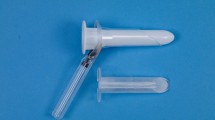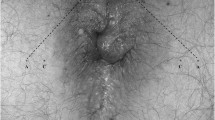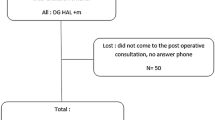Abstract
Background
Transanal hemorrhoidal dearterialization, although it showed reliability, has not completely removed the issue of postoperative pain.
Objective
We investigated the causes of postoperative pain and proposed some changes of the technique in order to eliminate it.
Patients
One hundred six out of 188 operated patients were considered. Postoperative pain was investigated using a Visual Analogue Score dividing patients into three groups: 0 to 3, 4 to 6, and 7 to 10. On the basis of these results, we proposed some variations of the technique. A second group of 25 patients was therefore treated with the modified technique. Statistical analysis was conducted using the Fisher’s exact test, two-tailed.
Main outcome
Pain intensity, surgical approach, and changes in the technique were analyzed, and a new proposal for a modified technique has been developed.
Results
The group of 106 patients, 64 males and 42 females, were divided: 71 III grade and 35 IV grade. Pain was detected in 37 cases (35 %).Fifteen males (23.50 %) were divided as follows: 8 mild and 7 medium or intense. Twenty-two females (52.38 %) were divided as follows: 11 mild and 11 with medium or intense. For what concerns the variable grade, the pain was present in 15 III G and 22 IV G with statistic significant difference (p value 0.00333). Among the 18 patients (7 males and 11 females) who had severe pain, they all had a number of mucopexies >4, while among 19 patients (8 males and 11 females) with mild pain, only 5 had a number of mucopexies >4, resulting in a statistic significant difference (p value 0.031). In the second group, pain was drastically reduced.
Limitations
We believe it is necessary to extend the sample in order to definitively adopt the proposed amendments.
Conclusions
The review of the causes of postoperative pain and the changes adopted compared with those proposed in literature have allowed us to greatly reduce postoperative pain.




Similar content being viewed by others
References
Moriaga K, Hasuda K, Ikeda T (1995) A novel therapy for internal hemorrhoidal artery with a newly divised instrument (Moricorn) in conjunction with a Doppler flowmeter. Am J Gastroenterol 90:610–613
Giordano P, Nastro P, Davies A et al (2011) Prospective evaluation of stapled haemorrhoidopexy versus transanal haemorrhoidal dearterialization for stage II and III haemorrhoids: three-years outcome. Tech Coloproctol 15(1):67–73
Infantino A, Altomare DF, Bottini C et al (2012) Prospective randomized multicentre study comparing stapler haemorrhoidopexy with Doppler-guided transanal haemorrhoid dearterialization for third-degree haemorrhoids. Colorectal Dis 14(2):205–211
Sajid MS, Parampalli U, Whitehouse P et al (2012) A systematic review comparing transanal haemorrhoidal dearterialization to stapled haemorrhoidopexy in the management of haemorrohoidal disease. Tech Coloproctol 16(1):1–8
Zampieri N, Castellani R, Andreoli R et al (2012) Long-term results and quality of life in patients treated with hemorrhoidectomy using two different techniques: ligasure versus transanal hemorrhoidal dearterialization. Am J Surg 204(5):684–688
Pol RA, van der Zwet WC, Hoornenborg D et al (2010) Results of 244 consecutive patients with hemorrhoids treated with Doppler-guided hemorrhoidal artery ligation. Dig Surg 27(4):279–284
Szmulowicz UM, Gurland B, Garofalo et al (2011) Doppler-guided hemorrhoidal artery ligation: the experience of a single institution. J Gastrointest Surg 15(5):803–808
Faucheron JL, Poncet G, Voirin D et al (2011) Doppler-guided hemorrhoidal artery ligation and rectoanal repair(HAL-RAR) for the treatment of grade IV hemorrhoids : long-term results in 100 consecutive patients. Dis Colon Rectum 54(2):226–231
Tempel MB, Pearson EG, Page M et al (2013) Survey of patients satisfaction after Doppler-guided transanal hemorrhoidal dearterialization performed in ambulatory settings. Tech Coloproctol. doi:10.1007/s10151-013-1104-x
Gupta PJ, Kalaskar S, Taori S et al (2011) Doppler-guided hemorrhoidal artery ligation does not offer any advantage over suture ligation of grade 3 symptomatic hemorrhoids. Tech Coloroctol 15(4):439–444
Ratto C, Dionisi L, Parello A et al (2012) Distal doppler-guided dearterialization is highly effective in treating hemorrhoids by transanal hemorrhoidal dearterialization. Colorectal Dis. doi:10.1111/j.1463-1318.2012.03146.x
Giordano P, Tomasi I, Pascariello A et al (2014) Transanal dearterialization with targeted mucopexy is effective for advanced haemorrhoids. Colorectal Dis. doi:10.1111/codi.12574
Elmèr SE, Nygren JO, Lenander CE (2013) A randomized trial of hemorrhoidal dearterialization with anopexy compared with open hemorrhoidectomy in the treatment of hemorrhoids. Dis Colon Rectum 56:484–490
De Nardi P, Capretti G, Corsaro A et al (2014) A prospective trial comparing the short-and-long-term results of Doppler-guided transanal haemorrhoid dearterialization with mucopexy versus excision hemorrhoidectomy for grade III hemorrhoids. Dis Colon Rectum 57(3):348–353
Tsunoda A, Kiyasu Y, Fuji W et al (2014) Comparison of the early results of transanal hemorrhoidal dearterialization and hemorrhoidectomy using an ultrasonic scalpel. Surg Today. doi:10.1007/s00595-014-0885-5
Schuurman JP, Borel Rinkes IH, Go PM (2012) Hemorrhoidal artery ligation procedure with or without Doppler transducer in grade II and III hemorrhoidal disease: a blinded randomized clinical trial. Ann Surg 255(5):840–845
Theodoropoulos GE, Sevrisarianos N, Papacostantinou J et al (2010) Doppler-guided haemorrhoidal artery ligation, rectoanal repair, sutured haemorrhoidopexy and minimal mucocutaneous excision for grades III-IV hemorrhoids: a multicentre prospective study of safety and efficacy. Colorectal Dis 12:125–134
Roka S, Gold D, Walega P et al (2013) DG-RAR for the treatment of symptomatic grade III and grade IV haemorrhoids: a 12-month -multi-centre prospective observational study. Eur Surg 45(1):26–30
Conflict of interest
The authors have no conflict of interest.
Authors’ contributions
Michele Rubbini is the principal author. Valerio Tartari contributed in collecting the data.
Author information
Authors and Affiliations
Corresponding author
Rights and permissions
About this article
Cite this article
Rubbini, M., Tartari, V. Doppler-guided hemorrhoidal artery ligation with hemorrhoidopexy: source and prevention of postoperative pain. Int J Colorectal Dis 30, 625–630 (2015). https://doi.org/10.1007/s00384-015-2148-3
Accepted:
Published:
Issue Date:
DOI: https://doi.org/10.1007/s00384-015-2148-3




